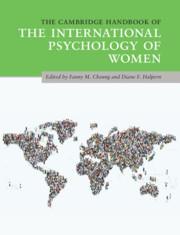Book contents
- The Cambridge Handbook of the International Psychology of Women
- The Cambridge Handbook of the International Psychology of Women
- Copyright page
- Dedication
- Contents
- Figures
- Tables
- Contributors
- Acknowledgments
- Section 1 The Underpinnings of Sex and Gender and How to Study Them
- Section 2 Developmental Perspectives of the International Psychology of Women
- Section 3 Cognitive and Social Factors
- Section 4 Work and Family Issues
- 19 Career Development of Women
- 20 The Psychology of Women in Entrepreneurship
- 21 Women’s Leadership across Cultures
- 22 Occupational Health Psychology and Women in Asian Contexts
- 23 Work–Family Interface and Crossover Effects
- 24 Intimate Relationships
- 25 Contextualizing the Many Faces of Domestic Violence
- Section 5 Inequality and Social Justice
- Section 6 Health and Well-Being
- Epilogue Some Final Thoughts and Take-Home Messages
- Index
- References
19 - Career Development of Women
An International Perspective
from Section 4 - Work and Family Issues
Published online by Cambridge University Press: 20 July 2020
- The Cambridge Handbook of the International Psychology of Women
- The Cambridge Handbook of the International Psychology of Women
- Copyright page
- Dedication
- Contents
- Figures
- Tables
- Contributors
- Acknowledgments
- Section 1 The Underpinnings of Sex and Gender and How to Study Them
- Section 2 Developmental Perspectives of the International Psychology of Women
- Section 3 Cognitive and Social Factors
- Section 4 Work and Family Issues
- 19 Career Development of Women
- 20 The Psychology of Women in Entrepreneurship
- 21 Women’s Leadership across Cultures
- 22 Occupational Health Psychology and Women in Asian Contexts
- 23 Work–Family Interface and Crossover Effects
- 24 Intimate Relationships
- 25 Contextualizing the Many Faces of Domestic Violence
- Section 5 Inequality and Social Justice
- Section 6 Health and Well-Being
- Epilogue Some Final Thoughts and Take-Home Messages
- Index
- References
Summary
This chapter discusses conceptualization, research, and intervention issues related to the career development of women. First, social and psychological factors affecting the career development of women are reviewed. Second, recent theoretical advances and formulations in career development most relevant to understanding the career challenges of women are examined. Third, research findings related to gender differences in career choices and interests are examined, including those that seek to explain differences in STEM-related interests and careers. Fourth, implications for career guidance and counseling are discussed in light of the literature reviewed. Overall, this chapter seeks to enrich the literature on the career development of women using an international perspective and suggest career development practices that can move our societies toward achieving greater gender equity.
Keywords
- Type
- Chapter
- Information
- The Cambridge Handbook of the International Psychology of Women , pp. 275 - 288Publisher: Cambridge University PressPrint publication year: 2020
References
Suggested Readings

Alvin Leung Seung-Ming is Dean of Education of the Chinese University of Hong Kong. Born and raised in Hong Kong, he received his doctorate in Counseling Psychology from the University of Illinois, Urbana-Champaign, and joined CUHK in 1996 after serving as a faculty member at the University of Nebraska-Lincoln and the University of Houston. His research focused on career development and assessment, cross-cultural and multicultural counseling, and counseling in educational settings. He is a Fellow of the American Psychological Association (APA) and of the Hong Kong Professional Counselling Association. He received the Distinguished Contributions to the International Advancement of the Counseling Profession Award from the Society of Counseling Psychology of the APA in 2008; the 2009 Distinguished Alumni Award from the College of Education, University of Illinois at Urbana-Champaign; the 2015 Life Time Contribution Award from the International Section of the APA Division of Counseling Psychology; the 2018 Outstanding International Psychologist Award from the APA Division of International Psychology; and the 2018 Award of Outstanding Contribution to the Profession of Chinese Career Development from the 2018 Shanghai Conference supported by NCDA. His co-edited book, International handbook of cross-cultural counseling: Cultural assumptions and practices worldwide received the 2010 Ursula Gielen Book Award from the APA Division of International Psychology. He is a member of several Hong Kong government advisory committees, including the Education Commission and Family Council. He is currently Chief Principal-Investigator of the CLAP for Youth @ JC, a large-scale career development intervention project for Hong Kong students organized by the Hong Kong Jockey Club Charities Trust.

Rachel Gali Cinamon is Full Professor at Tel Aviv University, Israel, where she serves as head of the Career Development Lab, and the post muster career-counseling program, as well as the School of Education. Born and raised in Israel, she attended Bar Ilan University where she obtained her PhD. Her research interests focus on career development of women, minorities and at risk populations, work–family relations through the life span, future plans and perceptions, and career interventions. Her research group involves several university–community partnerships that focus on career interventions in high schools and in civic organizations. Cinamon developed a special and unique career intervention model that emphasizes the importance of being involved in four major roles in order to increase well-being and life satisfaction: work, family, community, and leisure. Her work is driven by her deep commitment to human development and by her belief in her social responsibility for individuals’ health, well-being, and meaningful life. She is a mother of three children, a spouse, a friend, and a long-distance runner.



